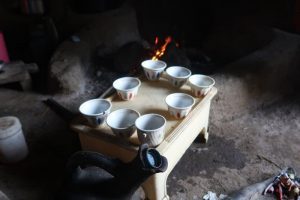Coffee is an everyday commodity that people all over the world enjoy. But did you know that coffee was born in Ethiopia? There you will find that coffee is more than just a cup of joe that you take to jumpstart your day or a study buddy during long hours at night. It is a significant part of Ethiopians’ lives — a livelihood, a culture, a symbol of respect and friendship. In fact, it is so important for them that they have a football team named “Ethiopian Coffee”, a contest called “Miss Ethiopian Coffee”, and even coffee-flavored condoms! The most interesting thing, though, is that they have this tradition called coffee ceremony or “jebena buna” in local Amharic tongue. It is a regular social occurrence meant to be shared with family and guests over several hours, and it is also an important opening to important events.
Curious? Let’s go through 8 facts about the coffee ceremony in Ethiopia…
#1 The ceremony is done daily for at least 2 hours
 Deemed as the most important social connection, the coffee ceremony lasts for about 2 to 3 hours. It’s common for families, especially those in traditional homes, to enjoy 2-3 of these ceremonies per day. Children participate in serving the coffee to the elders and most of the time, guests are invited. Conversation topics typically range from politics to community matters and many more.
Deemed as the most important social connection, the coffee ceremony lasts for about 2 to 3 hours. It’s common for families, especially those in traditional homes, to enjoy 2-3 of these ceremonies per day. Children participate in serving the coffee to the elders and most of the time, guests are invited. Conversation topics typically range from politics to community matters and many more.
#2 A young woman (or the woman of the house) always conducts the ceremony
 Considered an honor, an Ethiopian coffee ceremony is always conducted by a young woman or sometimes, the matriarch of the house. Since as children, they are regularly exposed to this ceremony and girls are always encourage
Considered an honor, an Ethiopian coffee ceremony is always conducted by a young woman or sometimes, the matriarch of the house. Since as children, they are regularly exposed to this ceremony and girls are always encourage
d to learn the requisite skills, it can be expected that the hostess is very adept. During the ceremony, she wears a traditional, ankle-length white cotton dress embroidered at its borders with colorful thread. Her movements is an art form.
#3 The ceremony is an elaborate process mainly composed of 3 stages
The three phases involved during the coffee ceremony are roasting, brewing and cupping. During the entire process, the host performs all three phases in front of all the attendees while simultaneously entertaining them.
- Roasting: The ceremony begins with raw coffee beans being washed then roasted over fire or stove in a long-handled pan called the menkeshkesh. In Tigrinya, menkeshkesh loosely translates to “the shaker”. The hostess decides how long the beans should be roasted but generally, she waits for it to be black and oily. Once done, the beans are then poured into a woven mat or plate made of lakha reeds called a meshrefet. The beans are spread out on the meshrefet and set aside in to cool, and guests are invited to enjoy the aroma of it. Also, before roasting, the hostess usually spreads fresh flowers and grass on the floor or ground while burning incense to make air more fragrant.

- Brewing: A ceramic, hand-made pot called jebana is the coffee brewing apparatus in the Ethiopian Coffee Ceremony. It is filled with water, not surpassing the stout, and set on the stove to boil. While waiting for the water to boil, the roastedbeans are then crushed or coarsely ground into fine powder using a wooden mortar called a muketcha with a metal or wooden pestle called a zenezena. When the steam from the jebena begins to rise, the hostess begins to pour water into the small cup containing the coffee grounds. It will form a thick liquid which is then poured back into the jebena. The host continues to do this back-and-forth motion until all of the grounds have been swept into the jebana. Then, the jebena will again be placed on the stove, allowing the steam to rise up again while ensuring that the contents do not overflow.
- Cupping: The very hot jebana is placed in its “chair” called kofmobelee jebana. The hostess then prepares small cups called finjals in which coffee from the jebana is gently poured from a few inches away. Each finjal of coffee is placed on tiny serving plates and wh
 ile guests areenjoying their cups, it is customary for them to shower the hostess with compliments. For the second, third and subsequent rounds, more water is added to the pot and reboiled, making each brew weaker than the other.
ile guests areenjoying their cups, it is customary for them to shower the hostess with compliments. For the second, third and subsequent rounds, more water is added to the pot and reboiled, making each brew weaker than the other.
# 4 The aroma of the roasted coffee is powerful and is considered to be an important aspect of the ceremony
After roasting, the hostess soaks each guest in the aroma created by the coffee’s smoke. She will come to each guest and at the same time, incense is burned to compliment the rich coffee fragrance. This part of the ceremony is considered iconic and very significant. If the aroma is found unwelcoming or unpleasant to guests, the host will have to start the entire process again.
#5 There are three rounds of coffee during the ceremony and guests are expected to not refuse the drink
With coffee being a sign of respect and friendship to Ethiopians, it is not customary to decline drinking the coffee during the ceremony and it is expected that at least 3 cups will be consumed. However, if coffee is politely declined for medical or religious reasons, for example, tea or Chai will most likely be served.
During the ceremony, three rounds of coffee will be served. The first one is black and naturally the strongest among the three. It is called abol or awel. The second one is tona, and the third one, which is the weakest and sometimes referred to as “one for the road”, is called bereka. According to folklore, these were the names of the three goats that led to the discovery of coffee (more about this later). Each cup symbolizes a progressive spiritual transformation. Literally, bereka means “to be blessed.”
#6 Serving the coffee is an art — and it doesn’t involve milk
 Serving the coffee is considered an art because the hostess masterfully and artfully pours the coffee in a single stream from about a foot above the cups. This is done slowly to avoid pouring grounds along with th
Serving the coffee is considered an art because the hostess masterfully and artfully pours the coffee in a single stream from about a foot above the cups. This is done slowly to avoid pouring grounds along with th
e coffee. The one who’s served first is always the eldest person or the guest of honor.Ethiopian coffee is also typically served with tena adam leaves and a spoonful of sugar — or loads of it. In the countryside, it may be served with salt instead of sugar, while in other regions, butter or honey may be added to the brew. However, coffee is never served with milk. Common coffee pairings include peanuts, ihmbaba (popcorn) and kolo (roasted barley).
#7 The coffee starts out as a fruit
It all starts with the unpicked, virgin coffee cherries. In Lalibela, they grow in abundance in almost every local’s backyard. The cherries, when red and ripe, are picked and peeled to expose the raw bean. The husks and debris are then shaken out of the beans until they are pure.
#8 The coffee ceremony stems from an interesting tale of how coffee was born in Ethiopia
Legend has it that the birth of Ethiopia started with a goat herder from Kaffa named Kaldi. Kaffa was a place in Ethiopia known for its plants that still grow wild in the forest hills. One day, Kaldi found three of his goats buzzed and very excited, almost dancing on their hind legs
 He noticed some mangled branches of a plant which bears red berries, and he knew his goats took them. So, he tried the berries himself and found that the result was incredible. He took the berries home and told his wife
He noticed some mangled branches of a plant which bears red berries, and he knew his goats took them. So, he tried the berries himself and found that the result was incredible. He took the berries home and told his wife
they need to tell the monks about it. The monks found the berries to be sinful drugs and so they tossed them in the fire, causing an aroma to fill the air. Some also say the monks crushed the beans and distilled the stimulating substance in boiling water. With the strong aroma filling the air, the monks in the monastery gathered around to investigate the substance. After hours, they discovered a renewed energy to their holy devotions where they stayed alert for many hours of prayer. The rest, they say, is history.
 In a book by Reginald Smith, “A History of Coffee,” it was discussed that Coffea arabica, the wild coffee plant, is indigenous to Ethiopia and was first discovered there in the year 850 A.D. This supports the claim that Ethiopia is the birthplace of coffee. The reputation of the energizing beans spread across the African continent at first. Other species of coffee were even discovered in different African countries. Eventually, the word about the energizing beans began to spread to the Arabian Peninsula, then to Europe, and then to the rest of the world.
In a book by Reginald Smith, “A History of Coffee,” it was discussed that Coffea arabica, the wild coffee plant, is indigenous to Ethiopia and was first discovered there in the year 850 A.D. This supports the claim that Ethiopia is the birthplace of coffee. The reputation of the energizing beans spread across the African continent at first. Other species of coffee were even discovered in different African countries. Eventually, the word about the energizing beans began to spread to the Arabian Peninsula, then to Europe, and then to the rest of the world.
You see, coffee in Ethiopia is a big deal. Besides its cultural and social symbolism, it is also Ethiopia’s number one export. In fact, about 2% of the world’s coffee comes from Ethiopia. And if coffee ceremonies is what you’re after, most cafes in Ethiopia these days also provide the experience. Watch this riveting video of a coffee ceremony in Ethiopia: Ethiopian Coffee Ceremony.











